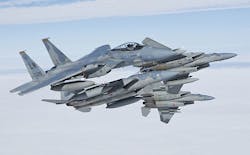Air Force asking industry for manned and unmanned adaptive self-healing airborne networks
Officials of the Air Force Research Laboratory's Information Directorate in Rome, N.Y., have issued a broad agency announcement (FA8750-18-S-7001) for the Aerial Layer Networking program, which seeks to create advanced airborne networks for contested and congested airspace.
Today's aerial layer networks limit combat effectiveness, especially in highly contested, operationally limited (CDO), and significantly congested environments in which communications can be considerably degraded.
Adequate capabilities for airborne network management are lacking today, Air Force researchers say, which creates a need for ways to manage and plan today's multi-information link based airborne networks and tomorrow's heterogeneous-based architectures.
This project will involve dexterous network management and recovery mechanisms to improve network reliability and survivability at the battlefield.
The goal is to develop technologies that will transform current aerial layer networking from a "stitched-together" state to a seamless, adaptive, and mission- and environmentally aware network, researchers say.
The Air Force is asking for industry white papers that describe hardware brass boards and software systems development; activities for validation with model-based design and simulation; and demonstration of hardware brass boards and antenna-in-the-loop validation techniques.
The project has three areas: airborne networking management and monitoring; directional airborne networking; and technologies for the Joint Aerial Layer Network (JALN).
Airborne network management and monitoring involves concepts, tools, and techniques for monitoring and management of current and emerging airborne networks. Researchers want to develop network technologies to improve network monitoring and management of existing AF multi-TDL networks and examine emerging network technologies. Contractors also will develop self-managing, self-healing autonomic wireless network capabilities, which may include software-defined networking and network function virtualization techniques.
Directional airborne networking will involve leading-edge capabilities in apertures, waveforms, and networking that will enable robust directional airborne networking. Researchers are interested in technologies to improve the security and reliability of aerial layer networks, and in developing next-generation directional mesh networking technologies capable of seamless operation across uncontested, contested, and highly contested airborne environments.
For this area, contractors will develop ad-hoc directional tactical edge mesh networking technologies in system level operation, RF front ends, radios and modems, link and topology control, and networking and system control.
Technologies for the Joint Aerial Layer Network (JALN) will involve capitalizing on advanced radio, networking, and management technologies for demonstration of JALN capabilities. Contractors will develop proof of concept demonstrations at lower cost, leveraging Air Force infrastructure to advance near-term networking technologies.
Related: Electromagnetic spectrum sharing among radar and communications systems moving forward
Total funding for the is about $10 million, and several contractors may be involved. For now, Air Force researchers are asking industry for white papers, and will invite those submitting the most promising ideas to submit formal proposals.
Companies interested should email white papers to the Air Force's Robert Husnay at [email protected], although white papers will be accepted until 28 Feb. 2019.
For technical questions and concerns contact Robert Husnay by email at [email protected], or by phone at 315-330-4821. For contracting questions contact Gail Marsh by email at [email protected], or by phone at 315-330-7518.
More information is online at https://www.fbo.gov/spg/USAF/AFMC/AFRLRRS/FA8750-18-S-7001/listing.html.
Ready to make a purchase? Search the Military & Aerospace Electronics Buyer's Guide for companies, new products, press releases, and videos
